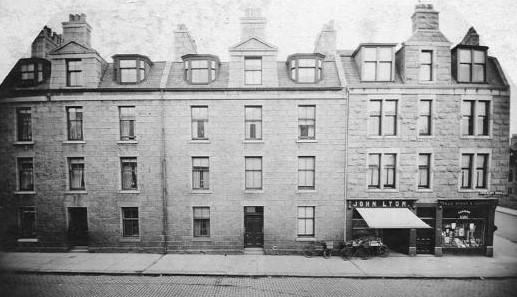In the heart of an Aberdeen tenement, a grotesque symphony of darkness unfolded, painting the walls with the blood of innocence. Helen Priestly, a mere eight years old, fell victim to the unforgiving grip of her neighbours, Jeannie, and Alexander Donald, in a web of hatred and resentment that had festered for far too long.
Within the confines of Urquhart Road, tensions simmered, a cauldron of animosity between the Priestly and Donald families, their disdain seeping into the very foundations of their existence. Jeannie, plagued by the incessant taunts of the innocent child, had become a festering vessel of malevolence, her fractured mind teetering on the precipice of madness.
Beneath the stairs of that forsaken tenement, a grotesque tableau awaited the unsuspecting world—a lifeless body concealed within the suffocating confines of a sack, a chilling testament to the depths of human depravity.
Petty insults and juvenile name-calling ignited the spark that set this tragedy ablaze. Helen, with her relentless persistence, had found solace in tormenting Jeannie, her innocent voice dripping with disdain as she branded her neighbour with the mocking moniker of “Coconut.” But within the fractured psyche of Jeannie Donald, a dormant rage lay in wait, a tempest of fury yearning to be unleashed.
On that fateful April day in 1934, Helen’s mother, oblivious to the horrors that loomed, entrusted her young daughter with a simple task—to buy bread from a nearby shop. But as the sun dipped below the horizon, Helen was nowhere to be found, she’d been to the bread shop, but the staff there were the last to see Helen before an unspeakable horror was unleashed upon her.
A shroud of darkness descended upon Urquhart Road; its residents plagued by the sickening truth that whispered through the shadows. The following day, the lifeless form of Helen Priestly emerged from the depths of despair, her fragile body violated by the asphyxiating grip of death. Whispers of unspeakable acts swirled in the wind, insinuating a horror far more sinister than anyone dared imagine.
The trial of Jeannie Donald in July 1934 gripped the nation, as the prosecution built a case against her for the heinous murder of Helen Priestly. The defence argued that the injuries inflicted on the child were consistent with rape, implying the involvement of a man. However, expert testimony from pathologists contradicted this theory, suggesting that the injuries were simulated to divert suspicion. The prosecution presented compelling forensic evidence, including the matching hairs and the presence of coal ash and cinders in the Donalds’ home, similar to those found in the sack containing Helen’s body. Overwhelmed by the weight of the evidence, the jury took a mere 18 minutes to find Jeannie Donald guilty of murder.
Jeannie Donald’s conviction brought a mix of relief and anger to a nation still reeling from the shocking details of Helen Priestly’s murder. However, controversy soon enveloped the case, as doubts arose regarding Jeannie’s mental state and her capacity to commit such a heinous crime. Psychiatrists questioned her mental stability, suggesting that she may have been suffering from a dissociative disorder. Advocates for her clemency argued that the evidence was circumstantial and failed to conclusively prove her guilt. Amid growing public pressure, Jeannie’s death sentence was commuted to life imprisonment.
Years bled into decades, etching lines of remorse upon Jeannie’s weathered face. Behind the prison walls, she languished, haunted by her actions. The world outside transformed, leaving her confined to a purgatory of guilt and regret. Finally, in 1944, the shackles that bound Jeannie were loosened, granting her a temporary reprieve from her prison cell. The dying embers of compassion flickered within the justice system, granting Jeannie a taste of freedom as she was released to care for her ailing husband.
Jeannie’s release, however, offered no solace or redemption. The weight of her sins bore heavily upon her fragile frame, the knowledge that she had taken a precious life forever etched into her conscience. The world outside those prison walls had transformed, but for Jeannie, time stood still, frozen in the eternal torment of her own guilt. As the years stretched on, Jeannie Donald became a ghostly figure, a phantom in the shadows of Aberdeen, haunted by her monstrous deeds. Isolated and shunned by society, she retreated into the depths of her own tormented mind, her existence a living purgatory, forever marked by the indelible stain of her crimes.
And so, in 1976, death became her ultimate liberation, a release from the shackles of her guilt-ridden existence. But even in her passing, the memory of her chilling crimes lingered, an eerie reminder of the darkness that can reside within the human soul. The tale of Helen Priestly’s murder and Jeannie Donald’s descent into madness remains etched in the annals of Aberdeen’s history, a chilling reminder of the depths to which human nature can descend. The tenement on Urquhart Road stands as a silent witness, its walls whispering the secrets of that harrowing chapter, forever haunting the hearts of those who dare to remember.
The chilling tale of Helen’s tragic end serves as a cautionary tale—a stark reminder of the fragility of innocence and the horrors that lie within the human psyche. It stands as a chilling testament to the depths of depravity that can be reached when fuelled by resentment and darkness. As the world moves on, the memory of Helen Priestly still lives on, her spirit forever intertwined with the chilling legacy of Jeannie Donald.
And in the quiet corners of Aberdeen, the story of their intertwined fate serves as a chilling reminder of the darkness that can lurk within even the most ordinary of places.
– The Dark Scotland website is created by Stewart and Louise – we run DD Tours, walking tours in Dundee city, covering dark local history such as wars, battles, murders, diseases, riots, disasters and executions. Walk with us for an unforgettable storytelling experience.




